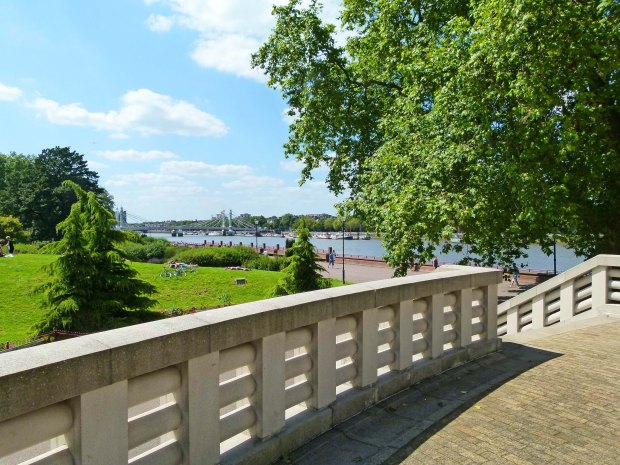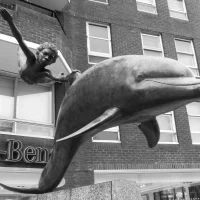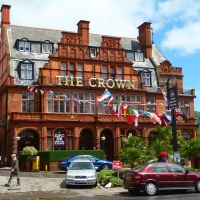Cabbie’s Curios: Battersea Peace Pagoda
The picture of the Pagoda below is not a holiday snap (unfortunately, I have not yet been lucky enough to visit the Far East!)
Believe it or not, this beautiful structure is in none other than London’s Battersea Park…
Officially known as the ‘London Peace Pagoda’, this sacred place was unveiled in 1985, its construction being undertaken by monks, nuns and followers of ‘Nipponzan Myohoji’; a Buddhist religious order dedicated to promoting world peace.
This order of Buddhism was founded by The Most Venerable Nichidatsu Fujii.

The Most Venerable Nichidatsu Fujii (also known as ‘Guruji’)
Born on a remote Japanese island on 6th August 1885, Nichidatsu Fujii embraced peace from an early age, becoming a Buddhist monk at the tender age of 19 and shunning the military career which was expected of him.
During the 1930s, he travelled to India, where he became friends with Mahatma Gandhi.
Gandhi, who with his doctrine of non-violence, proved to be a huge influence on the Buddhist Monk, bestowed his wise friend with the gracious nickname, ‘Guruji’; Guru or course meaning teacher, and ‘ji’ being a term which people in India attach to names and titles in order to denote respect.

Mahatma Gandhi, an indirect influence on Battersea’s Peace Pagoda
It was a name which stuck, with Nichidatsu Fujii’s followers happily referring to their mentor as Guruji for the rest of his life.
*
On the 6th August 1945, Guruji, Nipponzan Fujii turned 60. However, this milestone would prove to be a fateful anniversary for a far different reason…
That same August day, the world changed forever when the atomic-bomb known as Little Boy was exploded over the Japanese city of Hiroshima. This event was followed a few days later on the 9th August by a second nuclear blast; this time over the city of Nagasaki, forcing a rapid but horrific conclusion to WWII.

A pocket watch from Hiroshima, the hands melted at the time the atomic bomb detonated… 8.15am
As the Cold War set in, Guruji was horrified by these terrifying new weapons and, like many others across the globe, he believed the arms-race posed the gravest ever threat ever to civilisation. The venerable Buddhist’s view on the issue was summed up with the following words:
“Civilisation is not to kill human-beings, not to destroy things, nor to make war; civilisation is to hold mutual affection and to respect each other.”
As a response to the nuclear age, Guruji initiated a programme in which he endeavoured to build Peace Pagodas (also known as ‘Stupas’) all over the world; monuments intended to unite all of humankind, regardless of race, creed or nationality.
The first of the Peace Pagodas appeared in 1969, its location being Rajgir in India; a city of great importance to Buddhists, as it is believed this is where Buddha preached the influential, Lotus Sutra.

The first of the ‘Peace Pagodas’, located in Rajgir, India (photo: Wikipedia)
In Britain, there are two Peace Pagodas.
The first- a hauntingly elegant structure- was erected at Milton Keynes in 1980:

The UK’s first Peace Pagoda at Milton Keynes (photo: Geograph)
The second of course is the one in Battersea Park.

Battersea Park’s Peace Pagoda
This very special gift to Londoners, which stands at an impressive 33.5 metres tall, was inaugurated in May 1985, its purpose defined as being to “further humanity’s quest and prayer that the world may be saved from nuclear annihilation.”
In a sad and profound coincidence, Guruji died just 12 weeks before London’s Peace Pagoda was opened.
He was 100 years old…
The very last recorded words of Guruji; The Most Venerable Nichidatsu Fujii, were in relation to the Battersea Peace Pagoda as it neared its completion:
“I am delighted with the appearance of the precious stupa in London. May it assemble every effort to create peace. My wish has been accepted without question by the people of London and the world… nothing gives me greater happiness than this in my whole life”…

The Most Venerable Nichidatsu Fujii; Guruji in later life
*
The Peace Pagoda in Battersea Park features four sacred, gilt-bronze statues which chronicle the most significant stages in Prince Siddhartha’s (the Supreme Buddha’s) life… birth, contemplation leading to enlightenment, teaching and death.

The first two stages; birth and contemplation

Stages three and four… teaching and passing away…

The four stages of Buddha’s life, as represented by an illustrated plaque beside Battersea’s Peace Pagoda
*
Thanks to the influence of Guruji, there are currently 80 Peace Pagodas spread across the world.
Today, the Peace Pagoda in Battersea is in the care of Wandsworth Council… and, on a far more involved level, the Buddhist Reverend, Gyoro Nagase, who arrived in London from Japan in 1978 and participated in the Pagoda’s original construction.
Mr Nagase has much a huge task in caring for the sacred site- you can read more about his commitment here.
The Pagoda is open to the public all year round.
Its raised level in particular provides beautiful views over the Thames and across to Chelsea Embankment, making it a wonderful place to stand and contemplate; a true oasis of peace and calm in our often chaotic city.

Looking towards Albert Bridge from the Pagoda

Looking towards Chelsea Bridge from the Pagoda
If you do wish to visit the Pagoda, please bear in mind that the statues of Buddha, which rest in the upper alcoves, are sacred objects, and it is forbidden to climb upon them; something which many visitors in their enthusiasm fail to realise.
The Pagoda also plays host to a number of ceremonies throughout the year; the main ones taking place every June, in which Buddhists from many different backgrounds gather to offer prayers for peace, and on the 9th August (Nagasaki Day) when, at dusk, a floating lantern ceremony takes place, commemorating all victims of war.












